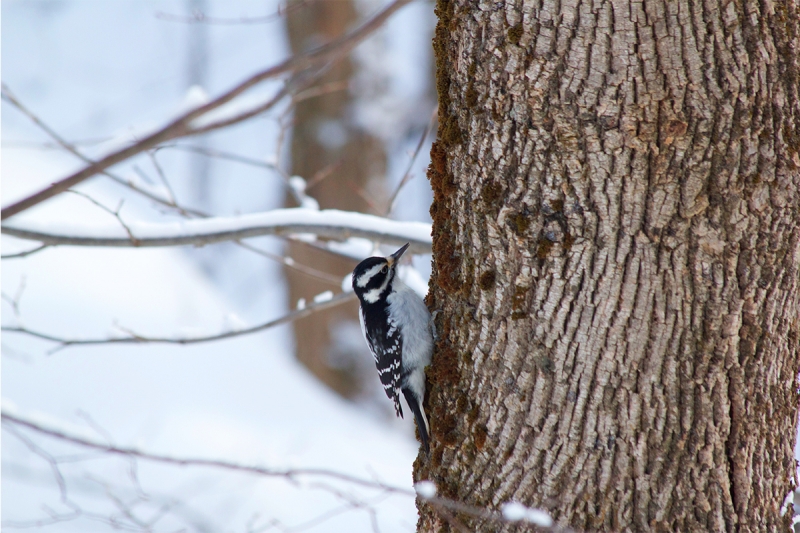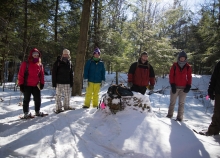
Our Neighbors in the Cold
By Justin Dalaba
Warm gear, check. Snowshoes, check. Lunches, check. Field journals, check. We have all the necessary gear we need to brave the cold for several hours in the woods before making our way back to home base, but what about the animals that thrive in the cold all winter? As college students we take for granted our ability to walk to the dining hall for food to sustain our energy and brain power. So how do the predators and prey of the woods survive in these uncomfortable conditions? These questions drive our Winter Ecology class outdoors each week to connect more pieces of the intricate puzzle of animal survival.
First tracks. As we make our way into Glenmeal State Forest, we immediately notice a new set of tracks in a direct-registering trot, parallel to our old tracks that have now been dusted with snow over the week. We identify these 1.5 inch wide footprints to be those of a fox based on its precise trotting pattern and relatively small size paw prints as compared to a coyote. Continuing along the trail, we intersect another new set of tracks. Larger than a squirrel with a clear four-toed print, we find this to be a rare crossing of a rabbit or possibly even a snowshoe hare. Attempting to stay on our trail, we move along and quickly come across a weasel trail, crisscrossing the forest floor to check in on the homes of vulnerable mice. Not that deep into the woods yet, we move along to make the best of our time.

Fisher Tracks Squirrel Tracks

Side tracked. First it was the mysteriously disappearing tracks of a grouse that caused us to break from our trail and search for its landing strip. Next it was the trail of a predacious fisher that caused us to sidetrack much farther from our path. As Bernd Heinrich wrote in Winter World: The Ingenuity of Animal Survival, when we anticipate the discovery of something uncertain, our journey can lead to something more valuable than we initially expected to find. After tracking the fisher for several hundred yards, we discovered a field of hemlock litter from a porcupine that had been munching away, leaving 45 degree angle cuts on the chewed twigs. After pacing around the site looking at the ground, we almost forgot to look up, and to our surprise we had been standing under a porcupine enjoying his lunch in the tree.
1 hectare to go. All the energy spent we on snowshoeing and side tracking made us hungry fairly quickly. No wonder animals limit their bouts of activity to conserve what energy their sparse lunches give them. We ourselves had to rest for lunch at our individual study sites, and after taking a moment to appreciate our surroundings and encounter some other discoveries, we moved on to the final exercise of the day: counting the tracks of species within a square hectare of deciduous and coniferous forests. Interestingly, we tallied a greater total number of animal tracks under conifer tress than under the deciduous trees. Perhaps this is consistent with the hypothesis that coniferous tree cover prevents heat loss into space from the snow that blankets the earth.
There is still much to observe and much to learn from our wild neighbors in the woods. This trip has given insight to a few more pieces of knowledge that could be useful to our understanding of adaptations of animals and plants to the cold.

